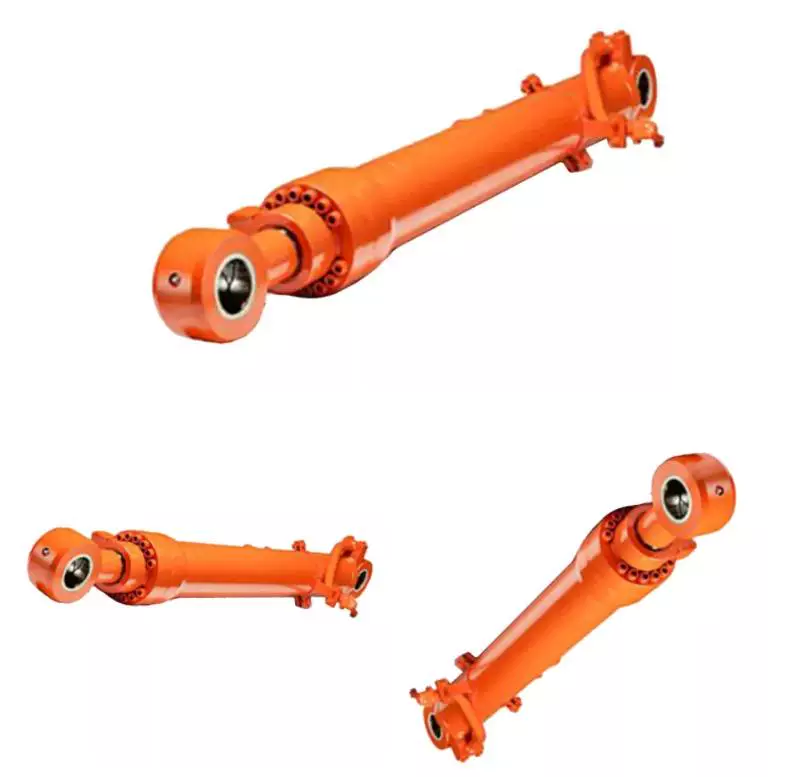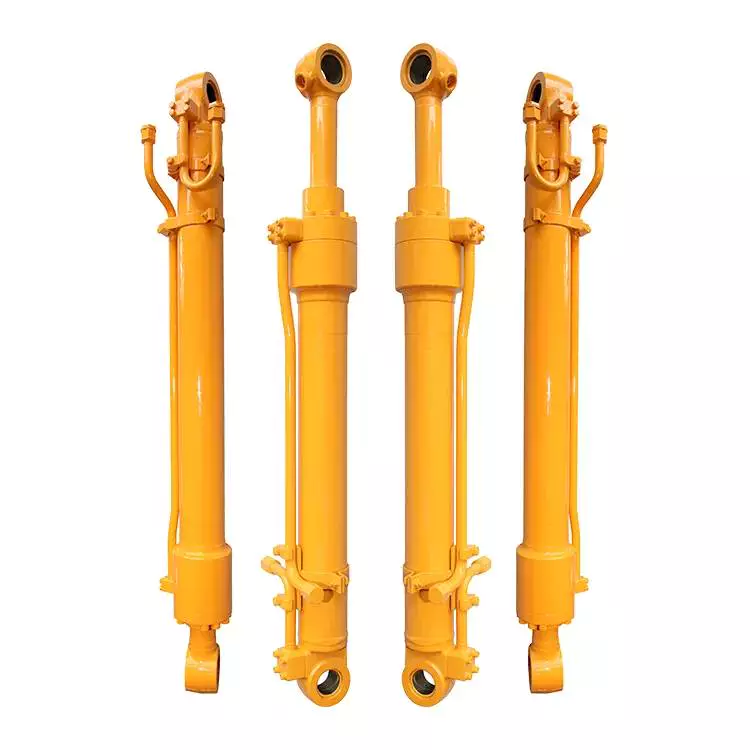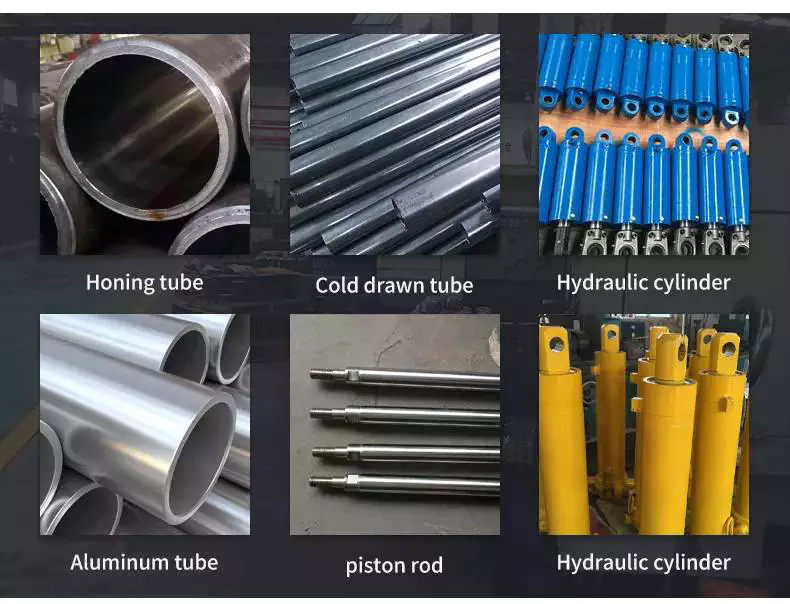Condition: New
Warranty: 1.5 years
Applicable Industries: Building Material Shops, Manufacturing Plant, Machinery Repair Shops, Food & Beverage Factory, Farms, Construction works , Energy & Mining
Weight (KG): 76
Video outgoing-inspection: Provided
Machinery Test Report: Provided
Marketing Type: New Product 2571
Warranty of core components: 1 Year
Core Components: piston rod
Standard or Nonstandard: Nonstandard
Structure: Piston Cylinder
Power: Hydraulic
Body Material: Steel
Product name: Multi Stage Telescopic Hydraulic Cylinder For Dump Truck
Certificate: CE
Material: 27SiMn
Color: Customer Requirement
OEM: OEM Services Provided
Type: Piston Hydraulic Cylinder
MOQ: 5 Pieces
Showroom Location: None
Packaging Details: IRON/WOODEN CASE AND CONTAINER
Port: HangZhou
Multi Stage Telescopic Hydraulic Cylinder For Dump Truck
Factory Design Customized Hydraulic Cylinder Characteristics:
Aerial working machinery send workpersonnel to the specified position in the air for constrution through lifting of platform, and it has higher reuirements for safety, reliability, comfort and handing due to his operation height.such cylinder products have achieved modularization, seriation and lightweight.
Products highlights:
1. The application of standardized design,welding and anti-looseness patent technologies makes the products more reliable;
2. Lightweight design can minimize weight to make the equipment securer and more efficient;
3. Simple design is convenient for dismantling and maintenance;
Specifications
| Item | Specifications |
| Product Name | Multi Stage Telescopic Hydraulic Cylinder For Dump Truck |
| Certificate: | CE, ISO9001 |
| Production Capacity: | 200,000 pcs per year |
| Sample Time | 7-10 days |
| Brand | NOLANSE or customer’s logo |
| Service | OEM & ODM |
| Piston Rod | Chrome or nickel plated,ground & polished piston rod |
| Seal Type | Parker,NOK, BUSAK SHAMBAN or as customer’s requirement |
| Tube | High tensile cold drawn tube, precision honed for extended seal life |
| Delivery Time | Based on order quantity. normally 15-30 days. |
| Price Advantage | Competitive factory price with guaranteed quality |
| Business Type | Manufacturer & Exporter |
Application
Hydraulic Cylinder Product Application
Nolanse’s quality custom products are produced for OEM applications in a wide variety of worldwide industries, including manufacturing engineering machinery, loaders hydraulic cylinders, vehicle cylinders, construction, forestry, waste management, mining, material handling, industrial applications, agriculture, manufacturing, transportation, marine applications and oil field equipment. Our success has been built on the engineering expertise and manufacturing capabilities we offer to meet the very specific demands of our industry clients.
Why Choose Us
1. Product Research & Development
Nolanse builds quality products that are developed with use in mind. We specialize in working with every customer to share ideas and gather critical information regarding hydraulic cylinder fit and performance requirements for your specific application. This is accomplished by establishing a very close technical rapport with each customer and their engineering, purchasing and R&D departments – the experts in your organization who know best what functionality, quality, size and cylinders characteristics are critical to your equipment. If our standard lines don’t suit your application, CZPT has extensive experience in custom hydraulic cylinder designs. We strive to develop dynamic, innovative and dependable hydraulic and machining solutions that exceed your expectations.
2. Hydraulic Cylinder Production
We have the advanced CNC machine tools, a horizontal machining center, a welding robot, parts cleaning agent, automatic assembly lines, automatic painting equipment etc. to hydraulic cylinder ensure a 360-degree quality control of the production process.
3. Hydraulic Cylinder Product Testing
We check all of the products, using fully equipped facilities and advanced instruments, regarding the performance, structure, size tolerance, roughness, hardness, pressure and sealing to ensure the hydraulic cylinder quality meets the requirements of our different customers.
4.Hydraulic Cylinder Product Certifications
Nolanse is ISO 9001 registered for the design and manufacture of hydraulic cylinders and precision machining.
5. Professional Hydraulic Cylinder Team
NOLANSE professional hydraulic cylinder team deeply understands the requirements and the technological advancement hydraulic ram. CZPT has been specialized in custom hydraulic cylinder development, manufacturing, sales, sample verification, order processing and product delivery, etc. CZPT is always working hard with passion to put our efforts to hydraulic cylinder technology and application.
Company Information
As a leader in hydraulic cylinder Design, Manufacturing and Custom Machining for over 36 years, CZPT has its own over 220 employees and over 55,000 square meters manufacturing factories. We have professional departments including hydraulic cylinder design, sales, production, quality control department, etc.
NOLANSE hydraulic cylinder products mainly include manufacturing engineering machinery,loaders hydraulic cylinders,vehicle cylinders,hydraulic systems and air controlling systems.It can also manufacture large-scale,non-standard and different stypes of cylinders, etc. All our hydraulic cylinder are manufactured from high quality raw materials with strict professional process and quality assurance. We had been worked hard and invested more to become the leader in hydraulic cylinder industry. Our partners are those famous hydraulic cylinder brands from America, Canada, Australia, Germany, England and other European Countries. Product quality, shorter delivery time and customer satisfaction are our long term commitment to our worldwide customers. Hope to be your partner.
Nolanse’s name has become synonymous with quality, on time delivery and exceptional service.
Join the growing number of partner relationship companies that trust and rely on the CZPT name.
FAQ
Q1:Can you provide a sample before a big order? A:Yes, we can .Q2:Are you CZPT to make Non-standard or customized air cylinders? A:Yes, we can, we have our own factory, we can satisfy the customers’ demandsQ3:How long is the warranty?A:We offer 12 months warranty time.Q4:Can I have my brand on the products?A:Of course you can.Q5:What is your delivery time?A:3-5days if we have stock, 15-25days if we have no stock.Q6:How about your quality?A:Most of the excavator/loader/Engineering vehicle companys is our customer in China, we also have confidence to supply good products to our foreign customers.
Hydraulic Cylinders and Their Components
Typically, a hydraulic cylinder is used in manufacturing machinery, construction equipment, civil engineering, and elevators. A hydraulic cylinder is also known as a mechanical actuator. A hydraulic cylinder is a type of mechanical actuator that is used to provide unidirectional force.
Piston rod
Choosing the correct rod for hydraulic cylinders can improve the performance and dependability of the machine. While the diameter is always important, the length is also crucial. If the length of the rod is too short, it will crush or fail. On the other hand, if the rod is too long, it will become twisted or misaligned.
The rod seal is the most important seal in a hydraulic cylinder. It protects the cylinder from fluid leaks and system pollutants. It also handles gradual changes in system pressure.
There are many types of seals for hydraulic cylinders. Some of them are special and designed to work under intense pressure. These seals also have backup rings.
A piston rod can be either hollow or solid. It is usually made of steel or stainless steel. It is often coated with hard chrome plating. A polished surface is also an option.
Choosing the correct seal is a crucial step in ensuring the longevity of your piston rod. Rod seals are subject to the most harsh conditions. They need to be made from materials that are slow to wear and will not contaminate the cylinder.
The correct rod seal is also important in preventing fluid leaks. They also protect the cylinder from pressure extremes in the system. If the seal fails, the cylinder will be damaged. The seal is also important because it prevents system pollutants from damaging the rod.
A hydraulic cylinder can be single acting or double acting. Single acting cylinders have one pressurized chamber while double acting cylinders have two. Typically, double acting cylinders have a piston that is extended under hydraulic pressure and retracts under hydraulic pressure.
Piston seals
Choosing the correct hydraulic cylinder piston seal is important to the operation of a hydraulic cylinder. There are various types of seals that can be used to help ensure proper operation of a cylinder. They range from single-action to double-acting seals. The seal’s material and its profile affect its performance.
The materials used to make piston seals range from rubber to thermoplastic polyurethane. The material’s elasticity and strength are also important. Typically, plastic seals have more focus on adding strength to the cylinder than on flexibility.
Rubber seals are used when a higher degree of flexibility is required. They are also used when a higher degree of compressibility is required. Some rubber seals are designed to withstand higher temperatures.
Piston seals are made from a variety of materials, including Viton, nitrile rubber, and polytetrafluoroethylene (PTFE). PTFE piston seals have less friction, which is a good thing. A PTFE seal is also able to handle higher temperatures.
In order to properly seal a cylinder, the seal must maintain contact with the cylinder bore. This ensures that fluid does not flow past the piston. The seal’s profile must also leave a small amount of oil film when it passes along the cylinder bore.
Thermoplastic elastomers are designed to offer superior elasticity. They also stand up to abrasion and high use. They also exhibit unmatched performance at extreme temperatures.
A piston seal can be designed to meet various requirements, including the highest pressures that can be expected. Some manufacturers offer custom sealing solutions. These solutions include testing, according to the customer’s specifications. They can also include failure analysis and system investigations.
Thermoplastic elastomers are also designed to be resistant to tearing. In addition, they are able to maintain a constant pressure for a longer period of time than other materials.
Mounting attachments
Using mounting attachments for hydraulic cylinders can reduce wear and tear on seals and bearings, and provide stability to the cylinder. There are three main groups of mounts: flange, lug, and clevis. Each style is designed for a different purpose. Choose the mount that is best for your hydraulic cylinder.
Flange mounts are a good choice for straight-line force-transfer applications. These mounts come in rectangular or square shapes and can be attached to the head or cap of a cylinder. They are very strong and are not prone to misalignment. They are also available in rod-end styles, which are recommended for tension applications.
Side lug mounts are used for small or light-duty hydraulic cylinders that require a straight-line force transfer. These mounts have lugs on the sides of the mount that are threaded to tie rods. These mounts are primarily used in confined spaces. The lugs can also be pinned on both sides of the mount to prevent movement of the cylinder. The lugs are also strong and can be used in high-pressure environments.
Clevis mounts are also used for arcing loads. They are primarily used on shorter stroke hydraulic cylinders. They can be mounted vertically or horizontally. They are usually used with a knuckle at the rod end of a cylinder. These mounts provide a single pivot point for mounting the cylinder.
Cylinder rod end attachments should be made from spherical bearings to minimize stress on the gland and piston rod. Ideally, they should be positioned as close as possible to the shoulder faces of the trunnion. They should also be threaded to tie rods for a secure connection.
The best mounting style for a hydraulic cylinder is an intermediate fixed-trunnion mount. This type of mount is a good choice for short stroke applications.
Common hydraulic cylinder components
Whether you are looking for a new hydraulic cylinder, or you are considering upgrading the hydraulic cylinders in your current machine, you need to understand the different components of a hydraulic cylinder. Cylinders are used in a variety of applications, including construction, mining, aircraft development, metal sheet shearing, and material handling.
A hydraulic cylinder is composed of two main components. These are the piston and the piston rod. The piston rod protrudes from the cylinder barrel and is attached to the piston inside the cylinder.
A hydraulic cylinder also has seals. These are used to prevent contaminants from entering the cylinder. They are made of many different materials, depending on the application. If the hydraulic cylinder will be operating at a high temperature, it may need a seal made of Viton. In contrast, a hydraulic cylinder operating at freezing temperatures may need a polyurethane seal.
Hydraulic cylinders are also designed to withstand a large amount of force, which means that they need to be able to withstand the pressure of the system. The pressure in the system must never exceed the rated design pressure of the cylinder.
Another important component of a hydraulic cylinder is the cylinder head. It is fitted with a rod gland seal, which encloses the pressure from the other end of the cylinder barrel. A hydraulic cylinder’s head can also be fitted with a check valve, which closes when the stem is clear.
A hydraulic cylinder’s head is also fitted with a rod bearing, which supports the weight of the piston rod. The rod bearing guides the piston rod through the rod gland, and prevents hydraulic oil leakage.
A hydraulic cylinder’s rod can be made from stainless steel or carbon steel. The rod is usually coated with hard chrome plating. The rod can also be made from corrosion-resistant materials, including Inconel.
Common causes of hydraulic cylinder drift
Having a hydraulic cylinder that drifts is not only dangerous, but it can lead to a lot of repair work and costly replacements. Luckily, you can diagnose and fix this problem by performing a few simple tests.
The first step is to ensure that the cylinder is in good working order. It should be checked for general wear, corrosion, and speed. Also, it should be checked for leaks. If there are any leaks, you should fix them right away.
Another way to determine if a cylinder is drifting is to use a pressure gauge. The gauge should be used under controlled conditions to determine if the cylinder is drifting. If the cylinder moves, the problem is likely a leak. You should also check the rod seal.
When the rod seal leaks, it allows fluid to leak outside of the cylinder system. If it does not leak, it should stick to the rod when the rod stops moving. This will prevent a cylinder from drifting and maintain pressure.
The most common cause of hydraulic cylinder drift is a leak. A leak can occur in a number of ways, including through the piston seal or a leak in the holding or pressure release valves. If the leak is in the piston seal, it can lead to a hydraulic cylinder that drifts.
Another common cause of hydraulic cylinder drift is fluid contamination. When foreign particles combine with the fluid, the density can change and oil can seep past seals.
Hydraulic cylinders can experience other issues as well. If the cylinder has an oversized piston diameter, it can cause cylinder drift. A load control valve can also be a problem.

editor by czh
